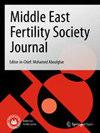Comparison between open and closed systems for vitrification of individual sperm: assessing morphometric measurements and chromatin integrity
IF 1.3
Q4 REPRODUCTIVE BIOLOGY
引用次数: 0
Abstract
Classic vitrification methods are not appropriate when there are minimal numbers of viable sperm, and the new methods emphasize the low semen volumes in these cases. The aim was to assess the efficacy of the cryotech as a device for freezing low sperm volume, through the two methods of open (OVS) and closed (CVS) vitrification systems. Testicular biopsy samples from 30 men with obstructive azoospermia (OA) were assigned to three groups fresh control (FC), OVS, and CVS. Testicular sperms were selected using an ICSI injection pipette and vitrified on the cryotech straws, containing one droplet of freezing medium. After warming, sperm head morphometric characterizations were evaluated with the MSOME technique. Sperm motility, membrane integrity, chromatin quality assessment including DNA fragmentation, Chromomycine A3 staining (CMA3), and Aniline Blue (AB) were assessed. Fluorescein isothiocyanate-conjugated Pisum sativum agglutinin (FITC-PSA) was done to examine sperm acrosome integrity. The mean sperm motility, viability, and sperm with intact acrosome reduced after vitrification, in both methods of CVS, and OVS, but the results were more promising in the closed method (p < 0.05). However, the variations were not significant between the two methods of cryopreservation, the OVS undergoes significant head dimensions changes compared to the control group (p < 0.05). The results also showed higher membrane, and chromatin abnormality after OVS (p < 0.05). The overall post-thaw recovery of human testicular sperm proposes that CVS is more efficient for single sperm cryopreservation, while higher sperm viability, and lower alterations in chromatin, acrosome, and sperm head morphometry were seen compared to OVS.用于单个精子玻璃化的开放式和封闭式系统的比较:评估形态测量和染色质完整性
当存活精子数量极少时,传统的玻璃化方法就不适用了,而新方法强调的是这些情况下的低精液量。我们的目的是通过开放式(OVS)和封闭式(CVS)玻璃化系统这两种方法,评估低温冷冻技术作为低精子量冷冻设备的功效。30 名阻塞性无精子症(OA)男性的睾丸活检样本被分为三组:新鲜对照组(FC)、OVS 组和 CVS 组。使用 ICSI 注射吸管选择睾丸精子,并在含有一滴冷冻培养基的低温吸管上进行玻璃化。升温后,用 MSOME 技术评估精子头部形态特征。对精子活力、膜完整性、染色质质量评估(包括 DNA 片段)、色霉素 A3 染色(CMA3)和苯胺蓝(AB)进行评估。异硫氰酸荧光素-结合豌豆凝集素(FITC-PSA)用于检查精子顶体完整性。在 CVS 和 OVS 两种方法中,玻璃化后精子的平均运动能力、存活率和顶体完整的精子数都有所下降,但封闭法的结果更理想(p < 0.05)。然而,两种冷冻保存方法之间的差异并不显著,与对照组相比,OVS 的头部尺寸发生了显著变化(p < 0.05)。结果还显示,OVS 后的膜和染色质异常程度更高(p < 0.05)。人类睾丸精子解冻后的总体恢复情况表明,CVS 对单个精子的冷冻保存更有效,与 OVS 相比,精子存活率更高,染色质、顶体和精子头部形态的改变更少。
本文章由计算机程序翻译,如有差异,请以英文原文为准。
求助全文
约1分钟内获得全文
求助全文
来源期刊

Middle East Fertility Society Journal
REPRODUCTIVE BIOLOGY-
CiteScore
2.80
自引率
0.00%
发文量
32
审稿时长
45 weeks
 求助内容:
求助内容: 应助结果提醒方式:
应助结果提醒方式:


